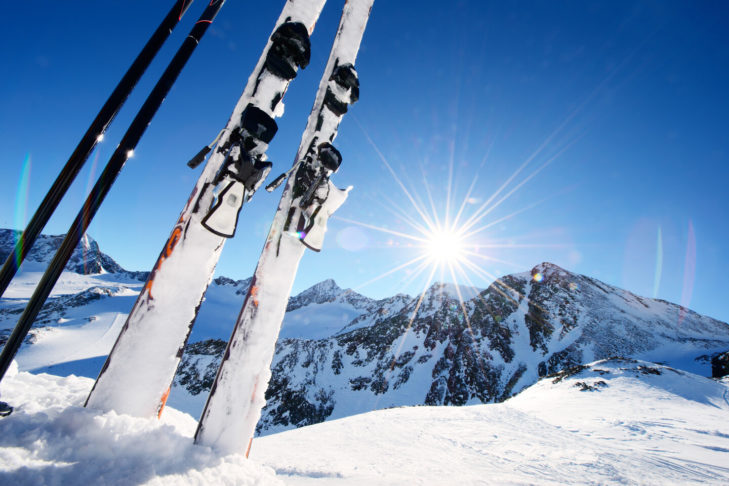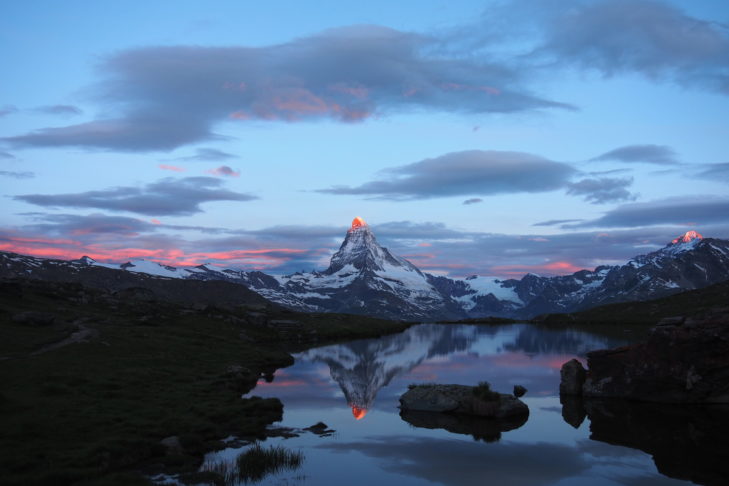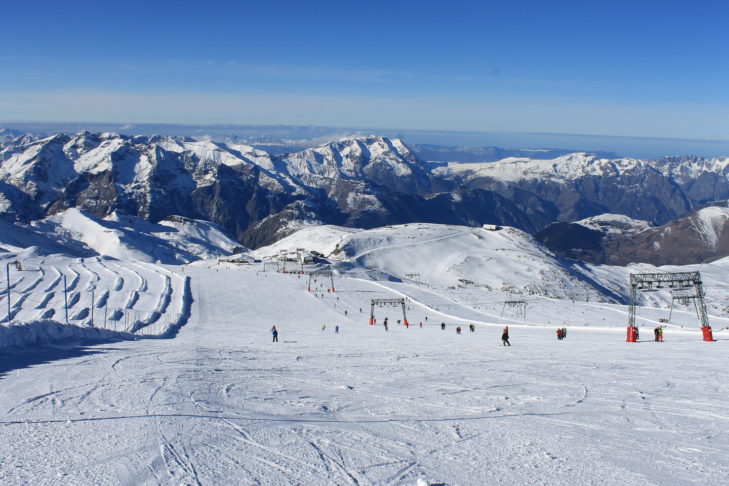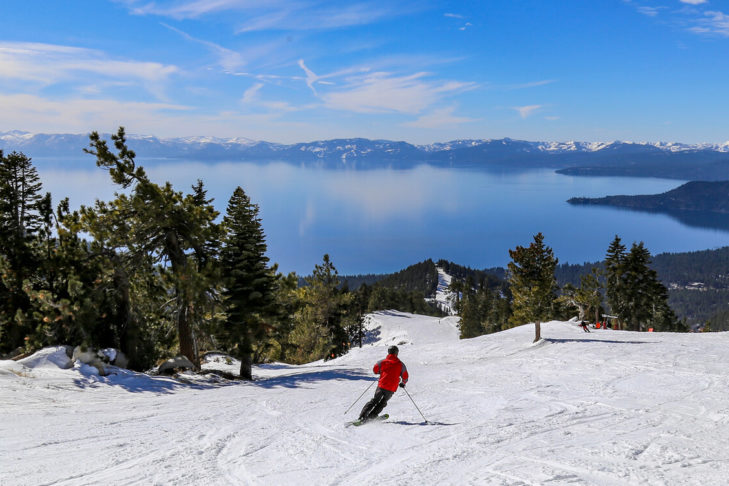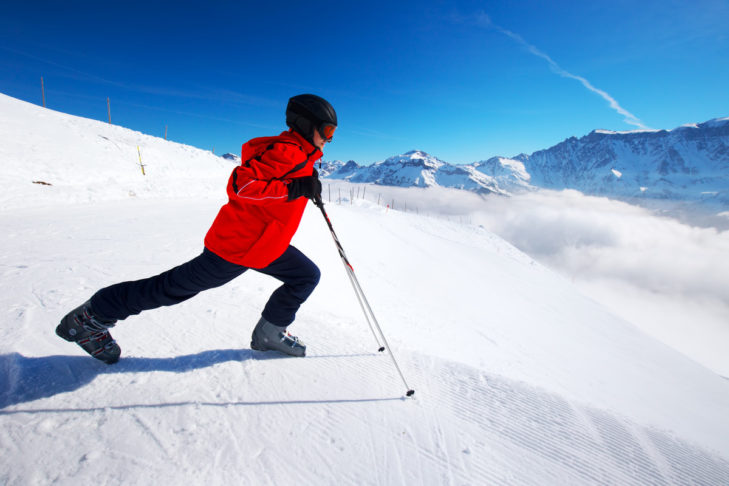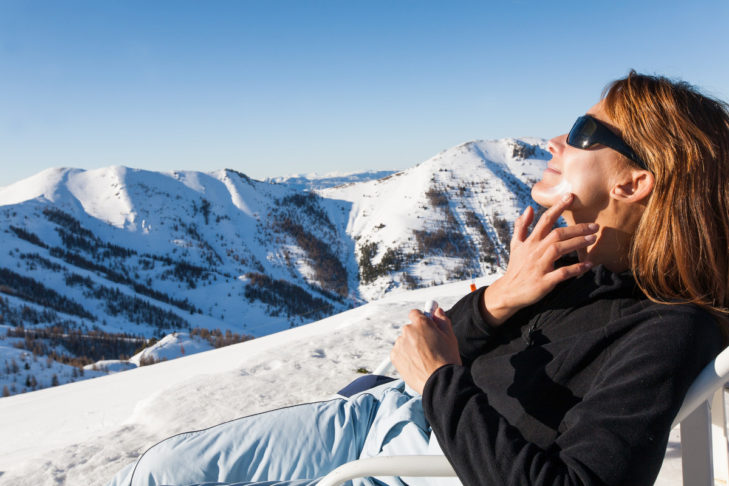In many ski resorts, the ski season comes to a close at the end of April. But that doesn’t mean that true piste fans can’t ski or board at all. For all those who don’t want to hang up their boards over the summer months, SnowTrex has compiled a list of ski resorts worldwide that don’t shut down their lifts at all or only for a short time. Skiing in summer is also possible here!
Summer ski resorts at a glance
| Ski area | Country | Highest altitude (metres) | Kilometres of piste |
|---|---|---|---|
| Zermatt | Switzerland | 3,899 m | 20 |
| Saas-Fee | Switzerland | 3,573 m | 20 |
| Les 2 Alpes | France | 3,523 m | 5 |
| Tignes | France | 3,456 m | 20 |
| Passo Stelvio | Italy | 3,450 m | 9 |
| Mammoth Mountain | USA | 3,369 m | 25 |
| Hintertux Glacier | Austria | 3,250 m | 20 |
| Palisades Tahoe | USA | 2,745 m | 10 |
| Timberline | USA | 2,603 m | 10 |
Zermatt (Switzerland)
Elevation: 1,562 – 3,899 m
Season ends: open all year long
Kilometres of pistes: up to 20 km
The Zermatt-Matterhorn region in the heart of the Valais Alps is surrounded by 38 four-thousand-metre peaks. The Theodul Glacier in the Matterhorn Glacier Paradise ski area is also open during the sunny months of June, July and August. The mountain station is located at 2,939 metres, at which point summer skiers can transfer directly to the glacier and be transported up to 3,899 metres. Up here, skiing is open almost all year round – depending on snow conditions – on over 20 kilometres of pistes.
Saas-Fee (Switzerland)
Elevation: 1,800 – 3,573 m
Season ends: end of October
Kilometres of pistes: up to 20 km
At the Allalin Glacier, skiers can enjoy 20 km of glacier pistes during the summer, with elevations reaching up to 3,573 meters. With more than just spring-like temperatures, many international ski teams also use the Saas-Fee ski area for training, so there’s always something to see off the slopes for the other guests. For those who prefer not to ski themselves, they can relax in a spacious chill-out zone with music or enjoy the glacier restaurant. Surrounded by 18 peaks over 4,000 meters, the Saas Valley is worth visiting even outside of winter, offering breathtaking panoramic views.
Les 2 Alpes (France)
Elevation: 3,200 – 3,566 m
Season ends: end of June
Kilometres of pistes: up to 5 km
One of the largest summer ski areas in Europe is located on the Mont-de-Lans glacier in the French Alps. The pistes reach up to an altitude of 3,566 metres, making this glacier ski area one of the highest in the world. It goes without saying that good piste conditions also prevail here in summer. Up to eight runs await advanced and professional skiers, who can also enjoy the triple deluxe summit panorama with La Meije, the Ecrins massif and, of course, the mighty Mont Blanc. The snow park is also open in good snow conditions. The only drawback is that the fun doesn’t last all day in summer, as the lifts only run until midday. Fortunately, Les 2 Alpes offers a full programme of activities after skiing, from glacier hiking and downhill biking to splashing around in the swimming pond.
Tignes (France)
Elevation: 1,550 – 3,456 m
Season ends: end of July
Kilometres of pistes: up to 20 km
Tignes and its ski area offer winter sports enthusiasts a superlative of the French Alps – even in summer. The Vanoise Massif is extremely popular with many skiers and snowboarders thanks to the fact that they can ski here almost all year round. After all, good snow is almost guaranteed even in June thanks to the altitude of up to 3,456 metres. The pistes on the Grande Motte glacier are usually open until the end of July.
Passo Stelvio (Italy)
Elevation: 2,760 – 3,450 m
Season ends: beginning of November
Kilometres of pistes: up to 9 km
The glacier ski area on Italy’s highest mountain pass is only open in summer. The pass road with its 48 hairpin bends up to the pass summit at 2,760 metres is the only way to access the Stelvio Pass. Although it is asphalted throughout, it is closed to traffic in winter. Skiing on the glacier there is therefore only possible in summer. However, it is populated by many training groups who share the 9 km of pistes with the other skiers.
Please also note that by using our services and integrating the YouTube API Services, the YouTube Terms of Service and the YouTube API Services Terms apply and your use of our website is deemed to be acceptance of these terms.
Mammoth Mountain (USA)
Elevation: 2,424 – 3,369 m
Season ends: beginning of July
Kilometres of pistes: up to 25 km
The Mammoth Mountain ski resort in the US state of California is blessed with plenty of snowfall thanks to the capricious weather in the Sierra. In summer, a whopping 25 kilometres of slopes are open at an altitude of over 3,300 metres, served by up to ten lifts! As is typical for patriotic Americans, the summer skiing fun ends just in time for the bank holidays, Independence Day, on 4 July.
As the name suggests, “Operation Spring Shred” heralds the final sprint towards the summer season in the ski area on “Mammutberg” in spring:
Please also note that by using our services and integrating the YouTube API Services, the YouTube Terms of Service and the YouTube API Services Terms apply and your use of our website is deemed to be acceptance of these terms.
Hintertux Glacier (Austria)
Elevation: 1,500 – 3,250 m
Season ends: open all year long
Kilometres of pistes: up to 20 km
The Hintertux Glacier is the only ski area in Austria that is open 365 days a year for winter sports enthusiasts with skis and snowboards in tow. In ideal weather conditions, over 20 kilometres of pistes up to an altitude of 3,250 m can be skied over the summer, served by more than ten lifts.
Want to give your skis a good run on the piste? In summer, this is no problem on the Hintertux Glacier if the snow conditions are right:
Please also note that by using our services and integrating the YouTube API Services, the YouTube Terms of Service and the YouTube API Services Terms apply and your use of our website is deemed to be acceptance of these terms.
Palisades Tahoe (USA)
Elevation: 1,890 – 2,745 m
Season ends: beginning of July
Kilometres of pistes: up to 10 km
Let your gaze wander over the world-famous Lake Tahoe from the piste. Not only in winter, but also in the summer months, skiers in the Palisades Tahoe ski area can enjoy this fantastic view. And if the name of the Californian snow area doesn’t ring a bell, the region is probably still known by its old name: Squaw Valley. The 1960 Winter Olympics were held here at an altitude of up to 2,745 metres and skiers and snowboarders can still let off steam in the summer months on the slopes where sporting history was made more than six decades ago. However, the ski area here is only open at weekends (Friday to Sunday). Incidentally, the season itself ends every year on American Independence Day, 4 July.
Timberline (USA)
Elevation: 1,478 – 2,603 m
Season ends: end of August
Kilometres of pistes: up to 10 km
North of California, in the US state of Oregon, skiing is also permitted in the summer months. The glacier ski area around Timberline Lodge, which served as the film set for Steven King’s classic horror film “The Shining” in 1980, is open until the end of August. At an altitude of up to 2,603 metres, skiers and snowboarders can enjoy up to 10 kilometres of slopes and a fun park on the flanks of the Mt Hood volcano.
Not only in the Rocky Mountains, but also in Oregon, snow fans can enjoy more than just skiing. Snowboarding in particular is extremely popular in summer around the “Hood”, especially with the pros:
Please also note that by using our services and integrating the YouTube API Services, the YouTube Terms of Service and the YouTube API Services Terms apply and your use of our website is deemed to be acceptance of these terms.
Tips for skiing in summer
Check the piste conditions in advance
In summer, the snow conditions change very often. The sunny slopes are still frozen hard in the morning, while the snow begins to melt in the afternoon. As a result, the snow cover becomes very wet. At night, however, the low temperatures allow the snow to recoup. This cycle creates a compact, smooth piste and ever firmer snow coverage, which becomes increasingly challenging starting by midday at the latest. Snow thawed by the sun and then compacted by skiers also makes the descents more difficult for many winter sports enthusiasts.
Keep your level of fitness up
Fitness can be crucial on beautiful summer days. This is because changing piste conditions are often extremely demanding for winter sports enthusiasts. On hard, smooth snow, you need a lot of strength to make the right turns. On soft slushy snow, on the other hand, cornering becomes increasingly difficult. To prepare for this strain, ski gymnastics as well as strength and endurance training are recommended. In this way, premature signs of fatigue on the piste can be avoided. Going up the mountain every day well rested and warmed up can also help prevent injuries.
Use wax and keep your edges in good shape
The condition of skis and snowboards is very important when skiing in summer. Sharp edges are a must for the icy conditions in the morning, while a well-waxed base increases the ability to turn in wet snow in the afternoon. Our SnowTrex recommendation: Treat the edges daily with a grinding stone or rubber and re-wax daily with liquid wax.
Start your ski day in the morning
Slushy pistes in the afternoon are not everyone’s cup of tea, especially as some summer ski resorts close at midday. Winter sports enthusiasts who still want to hit the slopes should therefore start their skiing day early. That way, they can benefit from the perfectly groomed pistes and the hard snow conditions. An overview of the open pistes and lifts can be found on the piste maps and panoramic maps at the valley stations as well as on the ski resort’s website.
Don’t forget sun cream and something to drink
Another point that winter sports enthusiasts should not neglect in summer and even around Easter is sun protection. After all, the intensity of the sun’s rays is 33 per cent higher at 2,500 metres than at 300 metres. A waterproof sun cream with the highest possible sun protection factor is therefore a must in your luggage. If you sweat a lot, you should moisturise regularly. A lip balm with plant-based waxes or oils also protects the lips from drying out and blistering. Protective sunglasses should also be part of your compulsory equipment, as should a ski helmet.
Also highly recommended: drink plenty of fluids! At high altitudes and during physical exertion, the body needs more fluids. We recommend mainly teas or juice spritzers. Alcohol has no place on the mountain – it’s reserved for après-ski in the valley.
If you are looking for suitable offers for a ski trip to snow-sure glacier ski areas that are also open in summer, then SnowTrex is the right place for you.
FAQ’s on skiing in summer
How many ski resorts in Austria are open throughout the summer?
In recent years, many ski resorts in Austria have closed their summer operations to protect nature, meaning that there is now only one year-round ski resort in the Alpine republic. In Hintertux, skiers and snowboarders can enjoy up to 20 kilometres of pistes on the glacier, which is over 3,200 m high, even in the summer months.
In which French ski areas are the pistes also open in summer?
If you also want to ski in the French Alps in summer, you can do so in two ski resorts. In Les 2 Alpes, skiing on the glacier at an altitude of up to 3,566 metres runs on eight pistes until the end of June. In Tignes, on the other hand, the pistes on the Grande Motte glacier (3,456 m) are open for almost a month longer until the end of July.
Which ski areas in Switzerland are also open in summer?
In Switzerland, there are two ski areas open year-round that are particularly interesting for professional skiers seeking training opportunities. At Zermatt, in the Matterhorn Ski Paradise area, leisure skiers can also enjoy nearly 20 kilometers of slopes at heights up to 3,899 meters throughout the summer, depending on snow conditions. The same applies to the famous glacier ski area of Saas-Fee, located in close proximity. In the eastern valley of the canton of Valais, both professionals and amateurs can also make use of 20 kilometers of slopes at elevations of over 3,500 meters between May and September.

